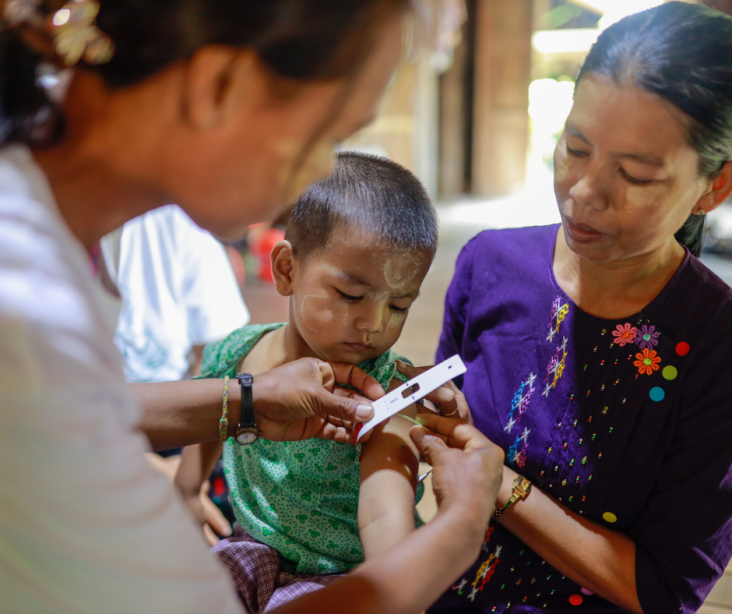Speeches Shim

OVERVIEW
U.S. assistance is reducing infant and child mortality, reducing the spread of infectious diseases, and improving access to live-saving health services in all parts of the country.
A large part of Burma’s population faces obstacles to realizing healthy, productive lives. A quarter of the country lives in poverty. Nearly a million people are estimated to need humanitarian assistance due to natural disasters or ongoing conflicts that are decades old. The country’s maternal and child mortality rates are among the highest in the region. Only 2.3 percent of Burma’s gross national product is spent in the healthcare sector, and the country has among the highest rates of out-of-pocket health expenditure in the world. U.S. Government investments focus on improving health for vulnerable and underserved groups – helping to mitigate sources of fragility arising from deep and longstanding inequities in health access - and addressing health threats such as multi-drug resistant malaria and tuberculosis (TB), and a growing HIV epidemic among people who inject drugs.
Eliminating the Burden of Infectious Diseases
Although Burma has made significant progress in the past decade, the country still ranks among the top 20 high-burden countries globally for TB, multi-drug resistant TB and TB/HIV co-infection. Malaria prevalence has declined more than 80 percent since 2012 with support from the Global Fund and the U.S. President’s Malaria Initiative, and the goal of elimination by 2030 appears to be in reach. Access to HIV/AIDS diagnosis and treatment has expanded substantially, though prevalence remains high among key populations, such as people who inject drugs, men who have sex with men, and sex workers. To address these challenges, USAID works with a diverse set of partners to develop and demonstrate locally effective approaches, and supports government, civil society, private sector, and community-based health organizations to apply them at scale. Under PEPFAR, USAID’s "innovate-adopt-amplify” strategy enables the U.S. to leverage other domestic and international resources that enhance the impact of U.S. investments. For example, USAID developed an intensified outreach methodology that resulted in dramatically increasing HIV case finding, which was then adopted by the Ministry of Health and Sports. USAID’s contributions to the Access to Health Fund also enhance the effectiveness of national and other resources by increasing their ability to reach remote and conflict-affected areas.
Engaging Ethnic and Community-Based Health Organizations
By supporting inclusion of ethnic and community-based private and non-profit health organizations, including in conflict-affected states, USAID programs also aim to support health as a bridge to peace and trust-building among ethnic groups, marginalized communities, and government, thus contributing to U.S. goals of reducing conflict and supporting the democratic transition.
KEY RESULTS from FY19
- The October 2019 Global TB Report highlighted Burma as the only high burden TB country in Asia on track to achieve 2020 milestones. TB incidence in Burma fell from 529 per 100,000 in 2009 to 339 per 100,000 in 2018, and case detection efforts are now picking up an estimated 76 percent of new cases, versus 49 percent in 2009.
- USAID activities notified 4,664 TB cases, helped the Ministry and partners to detect 3,281 multi-drug resistant cases, and distributed 212,025 TB rapid diagnostic kits.
- Burma advanced toward the goal to eliminate malaria by 2030. USAID malaria activities reached 1.4 million people in 2,473 villages across three states and regions.
- USAID activities purchased and distributed 625,000 LLINs and 787,500 malaria rapid diagnostic kits.
- USAID helped update national quality standards for 10 key maternal, neonatal, and child health service areas, and introduced a quality improvement model in five clinical sites, including Sittwe General Hospital in Rakhine state.
- USAID projects trained 1,077 female health workers in maternal and child health services.
- USAID supported competency-based training for 1,184 health workers across five states and regions in maternal and child health.
- USAID-supported training led the Ministry of Health and Sports to certify Ethnic Health Organization trainers in basic emergency obstetric and newborn, enabling them to pass these skills to health workers in areas not under government control.
- USAID collaborated with other bilateral donors to establish a new, $215 million Access to Health fund, focused on providing essential services to vulnerable people in conflict-affected and ethnic minority states, as well as urban populations affected by multi-drug resistant TB.
- In its first year, the USAID-supported 528 Love campaign attracted 58,000 followers on Facebook and reached millions of people with information for friends and family members of people struggling with addition, helping to increase awareness of HIV prevention.
USAID is committed to fostering equitable access to life-saving services to all the people of Burma as part of a holistic effort to advance human rights, peace and prosperity.


Comment
Make a general inquiry or suggest an improvement.